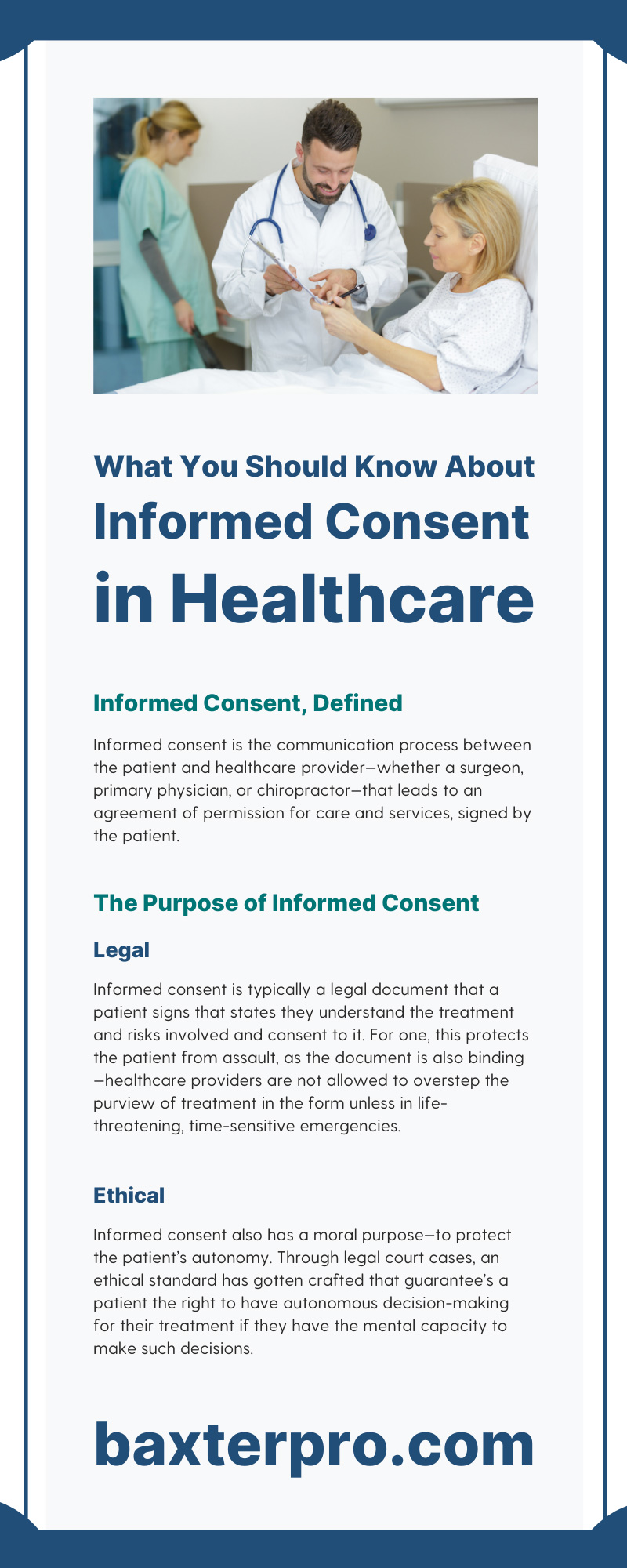
What You Should Know About Informed Consent in Healthcare
Mar 24 2023Informed consent is one of the most fundamental principles of healthcare. If you plan on working in the industry or want to learn more, we explain what every healthcare worker should know about informed consent below.
Informed Consent, Defined
First, let’s define informed consent and why it is important. Informed consent is the communication process between the patient and healthcare provider—whether a surgeon, primary physician, or chiropractor—that leads to an agreement of permission for care and services, signed by the patient.
Informed consent is also a legal right for the patient or their picked surrogate to have autonomy and choice regarding their treatment and the potential risks involved. If the patient can mentally make their own decisions, medical treatment and services cannot be performed without their consent. Their consent must include full knowledge of the treatment and potential complications.
The Purpose of Informed Consent
Those who work in healthcare should know that informed consent satisfies a legal, ethical, and administrative compliance purpose for both the patient and healthcare provider.
Legal
Informed consent is typically a legal document that a patient signs that states they understand the treatment and risks involved and consent to it. For one, this protects the patient from assault, as the document is also binding—healthcare providers are not allowed to overstep the purview of treatment in the form unless in life-threatening, time-sensitive emergencies.
It’s also a form of protection for the doctor as it states the potential complications of the treatment or procedure. The patient states on the form that they understand and consent to such treatment. This signature doesn’t completely shield the healthcare provider from potential malpractice should complications arise, but it’s valuable documentation that shows the patient understood the potential risks.
Ethical
Informed consent also has a moral purpose—to protect the patient’s autonomy. Through legal court cases, an ethical standard has gotten crafted that guarantee’s a patient the right to have autonomous decision-making for their treatment if they have the mental capacity to make such decisions.
For example, the ethical purpose of informed consent is that a patient can refuse treatment or procedures based on religious grounds, like a Jehovah’s Witness refusing a blood transfusion and not having autonomy or mental capacity questioned. It also has the moral purpose of ensuring that the patient has the right to set their own goals for treatment, not the healthcare provider.
Administrative Compliance
As the informed consent process is typically finalized with the signature on a written document, it also has an administrative compliance purpose. The informed consent form is a written document showing both parties’ consent regarding treatment and complications.
This simple document provides safeguards to fulfill the legal and ethical purposes of informed consent we discussed.
The Origins of Informed Consent
While it may seem obvious now, informed consent was not a legally binding concept until the 1950s. The origins of the legal concept as we understand it today were born out of multiple malpractice cases in the early twentieth century from patients against providers, and a standard legal concept got crafted out of these decisions.
In one case, a patient agreed to undergo an ear operation, but after they got anesthetized, the doctor changed plans and operated on the other ear, causing hearing loss. The patient sued the doctor for changing plans without her consent. Other cases involving doctors unintentionally and intentionally misleading or withholding information from patients or even performing different procedures than agreed to helped create the legally-binding foundation of informed consent as we know it today.
Elements of Informed Consent
An informed consent form and agreement must incorporate a few elements to get deemed truthful and legally binding.
Patient Competency & Explanation of Risks
For one, the patient must get deemed competent to understand and make healthcare decisions. In cases of mental health ailments, the patient and the healthcare provider can scrutinize and challenge this element.
If deemed competent, the informed consent form must also provide a sufficient explanation of the treatment, its benefits, and the risks. This explanation of treatment is the informed element of the form—if the healthcare provider withholds or includes misleading information regarding the treatment, they’ve violated the patient’s informed consent.
Patient Understands & Authorizes Treatment
The patient or the appointed decision-maker for the patient must understand the treatment, its benefits, and its risks fully. In healthcare, this can be difficult with such complex terminology and treatments, but it’s paramount for providers to feel they’ve explained it in detail and informed the decision-maker.
Once the patient or decision-maker understands, they must authorize the treatment plan, typically with a signature. Without a signature on the form, the healthcare provider can get found to have violated patient autonomy and be legally exposed.
What Chiropractors Must Know About Informed Consent
Informed consent is also an essential part of chiropractic healthcare. Since chiropractic care is an alternative treatment to other methods like drugs or surgery, the patients who visit chiropractic clinics are typically enthusiastic and willing to receive treatment.
Even so, it’s paramount that chiropractors explain the risks and details of every treatment and receive written authorization for treatment via an informed consent form.
Chiropractic Malpractice Issues Arising From Informed Consent Violations
While the risks associated with chiropractic treatment are relatively low compared to other types of treatment, malpractice issues can arise from informed consent violations. The most common complication that occurs from spinal manipulation treatment is muscle soreness.
Muscle soreness may not seem like a big deal, but if it debilitates the patient enough to where they can’t work, or their quality of life gets reduced, they may seek compensation. And without a signed informed consent form explaining that muscle soreness is a potential complication of chiropractic treatment, a chiropractor could get left exposed to a malpractice claim.
Conclusion
This shows the importance of understanding informed consent and having malpractice insurance for chiropractors. Every chiropractor should be intimately familiar with the legal parameters of informed consent and have forms ready for every patient about to undergo spinal manipulation treatment.
If you’d like to learn more about informed consent or need to find malpractice insurance for yourself or your practice, Baxter & Associates can help you learn more about medical malpractice and help find a policy plan that fits your situation.




